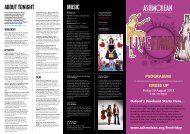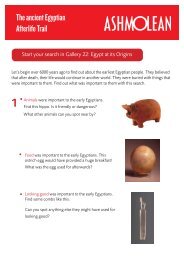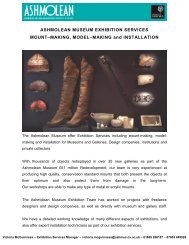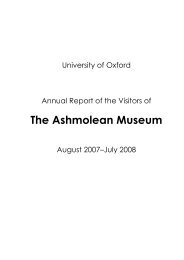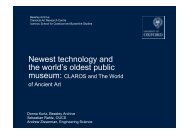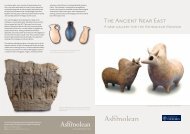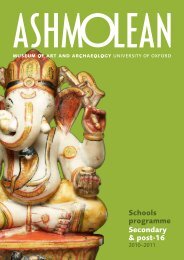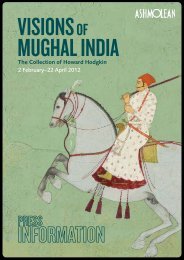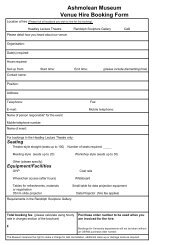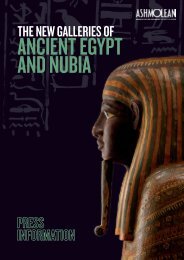A N N U A L R E P O R T - The Ashmolean Museum
A N N U A L R E P O R T - The Ashmolean Museum
A N N U A L R E P O R T - The Ashmolean Museum
Create successful ePaper yourself
Turn your PDF publications into a flip-book with our unique Google optimized e-Paper software.
Focus on Research / 27<br />
by both project and Decant. <strong>The</strong>y also agreed to undertake the bar-coding<br />
and digital photography of the reserve collection, again for the needs of offsite<br />
storage. Prior to the start of the Decant, they worked with Dr Chris<br />
Powell, Assistant IT Manager, on developing and piloting the integrated barcoding<br />
and digital photographic recording system to be used by both. <strong>The</strong><br />
extra work has been extremely time consuming, but the <strong>Museum</strong> is providing<br />
appropriate back-fill resources to the project. In the long-term, the additional<br />
work will provide a better Collections Management System and access for the<br />
material than envisioned in the original project design.<br />
<strong>The</strong> other major area in which the Historic British Archaeological<br />
Collections Project and the <strong>Ashmolean</strong> building redevelopment project will<br />
work together in a manner unforeseen in the original project design is in the<br />
design of the new galleries. <strong>The</strong> importance and/or scope of the historic<br />
British collections was not covered in the old <strong>Ashmolean</strong> displays. In the new<br />
building the subject will be addressed in a new gallery devoted to the History<br />
of the <strong>Ashmolean</strong> and Archaeology, to be designed by the Project Director<br />
assisted by the Project Manager. <strong>The</strong> project results will certainly have a<br />
major impact on the content of the gallery, which will also include key pieces<br />
from the historic collections that have been re-identified during the work –<br />
including such pieces as two Bronze Age flat axes illustrated by Dr Plot in his<br />
Natural History of Staffordshire (1685).<br />
<strong>The</strong> Historic British Archaeology Collections Project is fortunate to be able<br />
to benefit from association with three other Department of Antiquities<br />
projects on related topics. <strong>The</strong> Heritage Lottery Fund sponsors two projects;<br />
the first, ‘Preserving and enhancing access to historic Oxfordshire:<br />
archaeological archives held in the <strong>Ashmolean</strong> <strong>Museum</strong>’, concerns the records<br />
and collections of five early archaeologists working in Oxfordshire.<br />
Information concerning the project can be found on the <strong>Ashmolean</strong> website<br />
at http://www.ashmol.ox.ac.uk/ash/amps/oha/HomePage.html. <strong>The</strong> public<br />
access aspects of this project have yet to be completed pending resolution of a<br />
problem related to the University financial system. <strong>The</strong> second project,<br />
‘Archives and Artefacts: Exploring the past through A2A and the work of E T<br />
Leeds’, concerns the work of Edward Thurlow Leeds, former Keeper of<br />
Antiquities. A catalogue of his papers can now be found on the A2A website<br />
of the National Archives http://www.a2a.org.uk/, and full details of the<br />
project and its work with schools in preparing an educational resource for<br />
KS2 children on the Anglo-Saxons is available on<br />
http://www.ashmol.ox.ac.uk/ash/amps/leeds/. <strong>The</strong> Leverhulme Trust is<br />
providing funding for a three-year project entitled ‘Sir John Evans and the<br />
Development of Archaeology in Nineteenth-Century Europe’. Sir John Evans<br />
was one of the founders of the field of prehistoric archaeology, and was the<br />
person credited with establishing the antiquity of humans to the satisfaction<br />
of the scientific community in 1859. This project and the Historic British<br />
Collections Project will be good complements for each other in the coming<br />
year, one looking to the history of archaeology in Britain and the other to its<br />
development in Europe, and indeed the rest of the known world.




